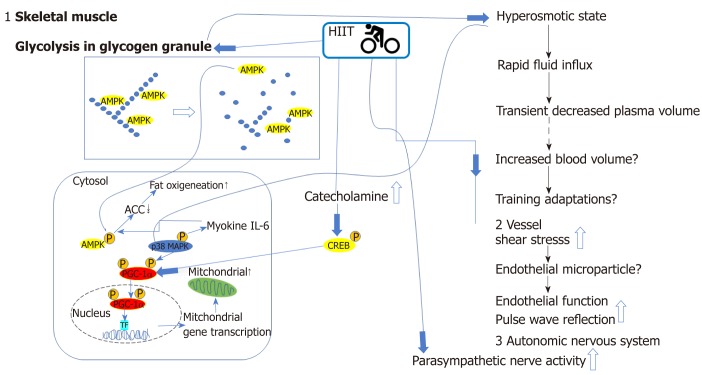Figure 2.
Graphic representation of beneficial cardiovascular and metabolic effects and relevant mechanisms activated by high-intensity interval training. Glycolysis of glycogen granules in the skeletal muscle, catecholamine release, increased shear stress in the vessels, and increased autonomic nerve activity by HIIT are related to increased aerobic and metabolic capacities. Activity in skeletal muscle cells and arteries are increased during HIIT. The decrease in glycogen content by glycolysis results in the release of the AMP-activated protein kinase (AMPK) from the glycogen particle, resulting in greater activity and altered localization. In addition, exercise in a low-glycogen state after glycolysis leads to the phosphorylation and activation of peroxisome proliferator-activated receptor γ coactivator 1-α (PGC-1α). Finally, the osmotic stress associated with a rapid change in glycogen content and increased glucose concentration can activate mitogen-activated protein kinases (MAPKs) such as p38, which can phosphorylate and activate PGC-1. Another target of p38 is interleukin 6 (IL-6), which targets AMPK as one of the potential targets. These alterations in muscle signaling also result in improved circulating fatty acid (FA) utilization. The increased catecholamine level promotes an increase in fat metabolism by activating heat shock protein through protein kinase A. An additional cellular target of catecholamine is the cAMP response element-binding protein (CREB). HIIT can increase the phosphorylation and activation of CREB in both exercised muscle and muscles that were not recruited during the exercise due to the central effects of elevated central nervous system activity. One of the targets of CREB is PGC-1α. An increase in PGC-1α mRNA and protein with co-activation of the transcription factor results in the increase in the mRNA and protein of the mitochondrial oxygenation enzyme, and finally, improvements in physical fitness (aerobic capacity). HIIT increases cardiac output, leading to shear stress in arteries and resulting in improvements in endothelial function and pulse wave reflection potentially through endothelial microparticles.ACC: Acetyl CoA carboxylase; AMPK: AMP-activated protein kinase; CREB: cAMP response element-binding protein; HIIT: High-intensity interval training; IL-6: Interleukin 6; MAPK: Mitogen-activated protein kinases; PGC1α: Peroxisome proliferator-activated receptor γ coactivator 1-α; TF: Transcription factor.

